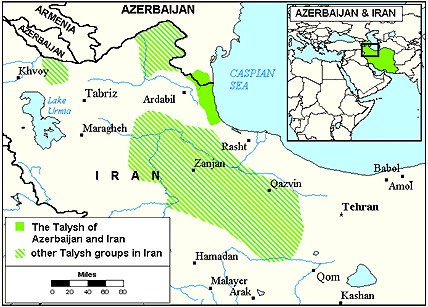The Talysh peoples inhabit the northwestern regions of Iran and part of neighboring Azerbaijan. They occupy a land of sharp contrasts, ranging from the high, forested Talysh Mountains to the subtropical coastal land along the Caspian Sea. They refer to themselves as the Talushon Although all of them speak their own Talysh dialect, most are also fluent in the local trade languages, especially Farsi. The Talysh have a number of subgroups, each with their own dialect, including the Central Tati. The Talysh have lived in the southwest Caspian Sea region for thousands of years. They came under Turkish influence during the Middle Ages, but established their own independent khanate, or kingdom, in the 1600s.
The lifestyles of the Talysh groups vary greatly due to the differences in their environments. However, regardless of the region in which they live, the majority of the Central Tati are farmers. In some areas, rice is the primary crop; in others, they grow wheat and barley. They raise tea and citrus fruits in the lowlands near the Caspian Sea. Many of them living in the lowlands cultivate fresh produce, including garlic, onions, pumpkins, melons, peas and grapes. Not all of the Central Tati are farmers. Some have become skilled craftsmen. Their primary handicrafts include silk, rugs and felt. Some work with tin, make shoes or design jewelry.
Central Tati Talysh live in various styles of houses, depending on the region in which they are located. Those in the mountainous areas typically live in flat-roofed homes built of uncut stone. Those in the coastal zone live in clay houses that have roofs made of reeds or sedge (grass-like plants with solid stems). The homes usually have high doors reaching to the ceiling, since there is no opening in the roof to allow smoke from the cooking fires to escape. The traditional Talysh homes have no furniture. However, today, a growing number of homes have adopted Western-style furnishings.
Central Tati Talysh women once wore traditional Muslim clothing, which consisted of veils over their faces and long robes that completely covered their bodies. Today, many Central Tati women have abandoned the customary outfit and wear Western-style clothing. Although Islamic law permits men to have as many as four wives, most Central Tati men take only one wife. Boys usually marry while they are between the ages of 15 and 20. Girls usually wed while they are between the ages of 12 and 16. The groom's family is required to pay a bride-price which consists of money and items such as carpets or utensils. To avoid paying the bride price, a young man will sometimes "kidnap" the prospective bride, taking her as his wife.
The Central Tati Talysh are virtually all Muslim, primarily of the Shia branch. They consider Jesus to be a prophet, a teacher, and a good man, but not God's son. Since Islam is a religion of works, they believe that after death they will be judged by their good deeds and by their knowledge of the Koran. Like other Muslims, they observe the five "pillars" of Islam, which include affirming that Allah is the only god and Mohammed is his prophet, praying five times a day, giving alms, fasting, and making a pilgrimage to Mecca. Although the Central Tati Talysh are professing Muslims, some remnants of their pre-Islamic religion remain. For example, they have a great reverence for trees and groves, and trees form some of their most sacred sites. They also believe in the presence of both good and evil spirits, with the most dangerous spirit being Alazhan, the "Red Woman. " Alazhan is believed to attack women during childbirth, as well as newborn babies.
Very few have had an opportunity to hear a clear presentation of the gospel. These precious people are in desperate need of biblical resources in their own language. There is a need for Holy Spirit-anointed and willing laborers to effectively reach these groups with the light of the gospel. Most importantly, they need people who will begin to faithfully intercede for them, tearing down the strongholds that are keeping them in spiritual bondage.
Pray for the Central Tati people to be blessed with peace, joy and spiritual prosperity as they follow Jesus Christ.
Pray for intercessors to faithfully pray for the Talysh peoples of Iran and Azerbaijan. Pray that God will send culturally sensitive ambassadors of Christ who will show the Central Tati people the way to the cross. Pray for a movement to Christ to grow exponentially.
Scripture Prayers for the Tati, Central in Iran.
https://www.timelessmyths.com/history/talysh/
https://en.wikipedia.org/wiki/Talysh_people
https://www.encyclopedia.com/humanities/encyclopedias-almanacs-transcripts-and-maps/talysh
| Profile Source: Joshua Project |











